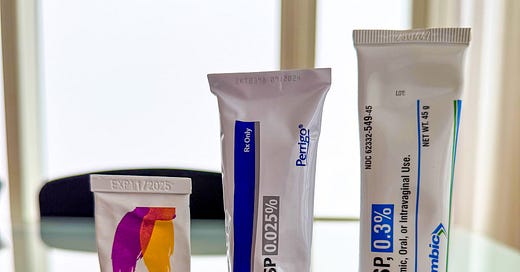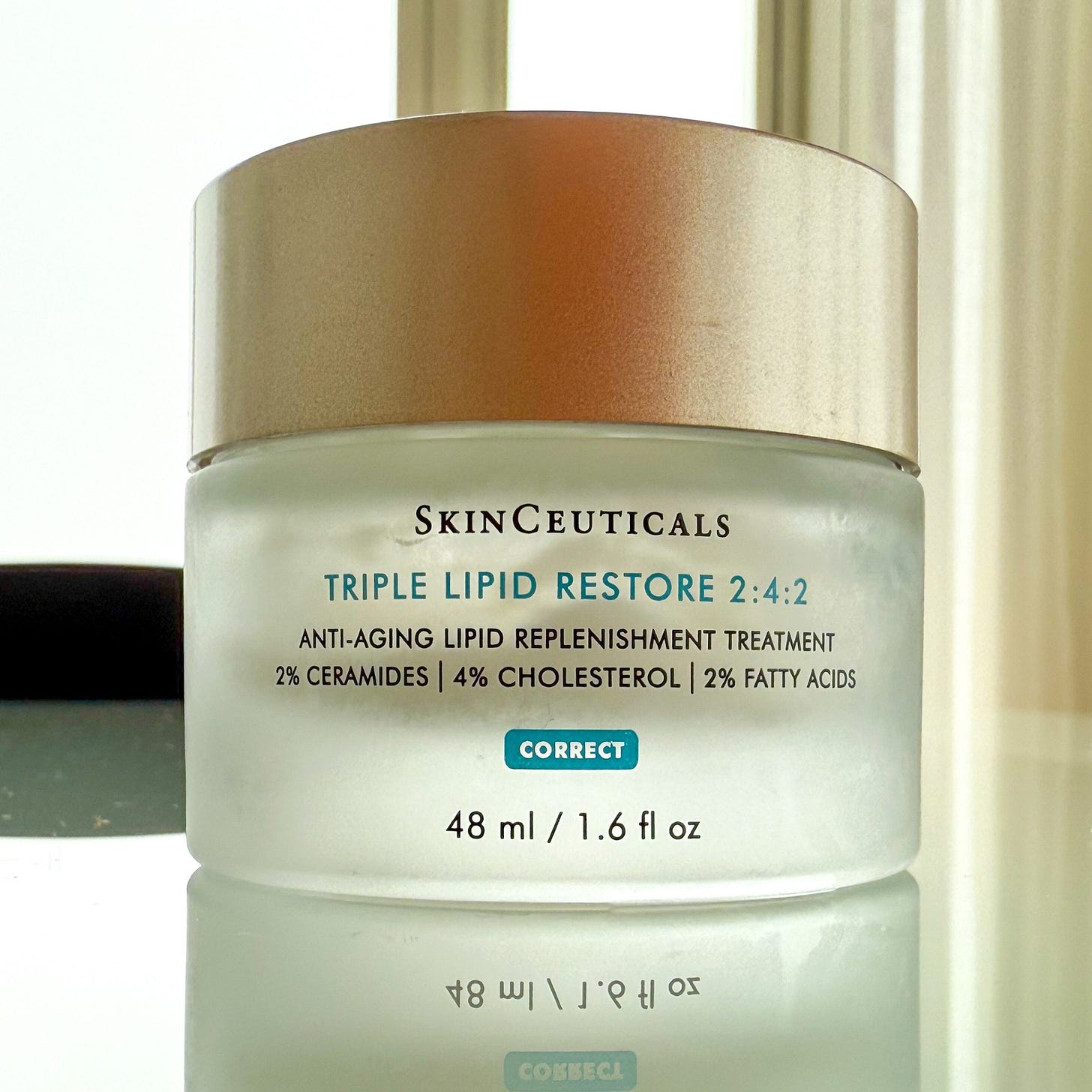Lip Service 💋 #3: The One Ingredient To Rule Them All -- Retinoids
Lifting the curtain on skincare’s most powerful cult classic.
If you enjoyed this read, don’t keep it to yourself—share it with a fellow beauty lover. And if you haven’t already, subscribe to the Lip Service Ledger so you never miss a drop of beauty wisdom. Thank you!
Ciao, beauty!
If there’s one skincare ingredient that truly does it all, it’s retinoids. Often called the gold standard of skincare, they boost collagen, refine texture, fade hyperpigmentation, smooth fine lines, and even prevent breakouts—basically, they’re the closest thing we have to an all-in-one miracle.
For years, derms swore by them, but recently? Retinoids have gone viral. Skincare lovers everywhere are hopping on the bandwagon, flooding social media with before-and-afters and glowing testimonials. But with so many options on the market, finding the right one is harder than you’d think.
That said? My first experience with retinoids was pure chaos. I made every rookie mistake: using way too much, skipping moisturizer, and pushing through peeling skin like some kind of exfoliation warrior (spoiler alert: terrible idea). My skin’s barrier paid the price, and I learned the hard way that retinoids are game-changing—but only if used correctly.
So, to save you from the face-burning hell I went through, we’re breaking down what retinoids actually are, how they work, and how to find the right one for you—without the trial-by-fire.
💡 The TL;DR: Retinoids 101
So, What Is a Retinoid?
Retinoids are Vitamin A derivatives that speed up cell turnover—essentially telling your skin to act younger, shed damaged cells faster, and boost collagen production. The result? Smoother, fresher, firmer skin with fewer breakouts and more glow.
Sounds like a dream, right? It is—but there’s a catch. Retinoids are powerful. They work at the cellular level, changing how your skin regenerates, which means they can also cause irritation, dryness, and peeling if not used correctly.
Not all retinoids are created equal. They come in different strengths, from gentle, over-the-counter options to potent, prescription-only formulas. The rule? The stronger the retinoid, the faster the results—but also the higher the risk of irritation. Finding the right one is all about balancing effectiveness with what your skin can tolerate.
The key difference? Bioavailability.
Retinoids that are closer to pure retinoic acid (like tretinoin) are more bioavailable, meaning they work immediately upon application without needing conversion. These are the most potent.
Retinoids that are further from retinoic acid (like retinol or retinyl esters) require multiple chemical conversions in the skin before they become active. The more conversions needed, the gentler—but also the slower—the results.
💡 The Beauty Breakdown
Choosing the right one means understanding where each retinoid falls on the strength spectrum and how much power your skin can handle.
From Most Gentle to Most Potent: Your Retinoid Cheat Sheet:
Retinyl Esters (Most Gentle, Slowest Results)
These are the weakest form of Vitamin A, requiring multiple chemical conversions before turning into active retinoic acid. They’re less effective but very gentle, making them ideal for first-timers or ultra-sensitive skin. Think of this as dipping your toes into the retinoid world.Retinol (Most Popular, Beginner-Friendly)
A staple in over-the-counter skincare, retinol takes time to convert into retinoic acid, meaning it works—but slowly (think 6–12 weeks for noticeable results). It’s a great starting point if you want visible anti-aging and skin-refining benefits without jumping straight into prescription strength.Retinaldehyde (Retinal) (Faster & Stronger Than Retinol)
A step up from retinol, retinaldehyde only needs one conversion to become retinoic acid, making it more effective while still being tolerable. It’s ideal for those who have used retinol and are ready to level up without committing to a prescription.Adapalene (Acne-Focused, OTC & Prescription Available)
A synthetic retinoid originally designed for acne, adapalene is more stable and less irritating than tretinoin but highly effective at keeping pores clear and reducing breakouts. It’s a great option if acne is your main concern or you want a more predictable, low-irritation experience.Tretinoin (Prescription-Only, Most Potent for Aging & Acne)
Tretinoin is pure retinoic acid, meaning it works immediately without needing conversion. It’s the most studied, dermatologist-approved form of retinoid and delivers dramatic results—but it’s also the most irritating. If you’re serious about treating fine lines, hyperpigmentation, or persistent acne, tretinoin is the fastest route there—but patience and barrier repair are key.
Some Pro-Tips to Start Using a Retinoid (Without Destroying Your Skin):
Start with a low-strength formula – If you’re new, try retinol or retinal before jumping to prescription.
Cut out your other actives – Minimize the chance of irritation by temporarily removing other actives from your routine.
Use it 2x a week at first – Give your skin time to adjust before increasing frequency.
Moisturize before & after – Buffering with a retinoid and following application with a barrier-supporting moisturizer helps to minimize irritation.
Always wear SPF. Retinoids make your skin extra sun-sensitive, and skipping sunscreen is basically hitting “undo” on your entire routine. Need more reasons? Check last week’s newsletter. (Side note: a friend told me he uses retinoids without SPF… I’m still recovering from the shock. Don’t be that guy.)
I’ve been using prescription-strength Adapalene (0.2%) for the past year, and after the initial adjustment period (read: some flaking, mild irritation, and a love-hate relationship with my moisturizer), my skin has never looked glowier or healthier.
The tiny, stubborn comedones on my forehead? Gone.
The dark spots from my teenage breakouts? Fading fast.
And while I may be only 24, my fine lines and early signs of aging? Consider paused.
Adapalene has been a game-changer, not just for breakouts but for overall skin clarity and texture. If you’re looking for a retinoid that’s powerful but less irritating than tretinoin, adapalene is a stellar option—especially if acne, congestion, or early signs of aging are on your radar.
✨ Beauty Rx: SkinCeuticals Triple Lipid Repair
All thoughts, opinions, and cheeky commentary are entirely my own. Every product featured here was purchased with my own money—no sponsorships, no freebies, just honest-to-glow reviews.
I’m sure everyone has heard of SkinCeuticals’ cult-favorite moisturizer, Triple Lipid Restore—but not always for the right reasons. With its eye-watering price tag of nearly $150, it’s a product that sparks as much debate as it does praise.
And as much as it pains me to say it? I think it’s worth every penny.
Picture this: a very frustrated Lauren, two weeks into her retinoid journey. My skin? Peeling, perpetually pink, and painfully irritated. Smiling? A risk of cracking. Flaking? Constant. Leaving the house? A humbling experience. I hated how my skin looked, but more than that, I hated how it felt.
Enter Triple Lipid Restore, purchased in a moment of pure desperation. A painful $150 later, I was slathering it onto my raw, irritated skin, sealing it in with a layer of Vaseline, and praying for a miracle.
And reader? It delivered.
My skin healed faster than I ever expected. This moisturizer melts into the skin, strengthens the barrier, and keeps me hydrated like no other product. A little goes a long way, making that steep price tag slightly easier to justify.
Would I rebuy it? Unfortunately for my wallet, yes. 🫠
💄 The Gloss Report
As much as I love talking about well-aging products, I can’t ignore the fact that our youth-obsessed beauty culture isn’t exactly healthy. The pressure to look eternally young has always existed, but with Gen Alpha scooping up Drunk Elephant serums like they’re candy, it’s clear that we’ve reached a new extreme.
California Assemblymember Alex Lee has proposed a bill that would ban the sale of anti-aging products to individuals under 18. The bill specifically targets products containing retinol and AHAs, aiming to protect young consumers from both unnecessary skin damage and the psychological impact of early beauty standards.
💋 Final Touch
I know this was a long one, but I hope you picked up a few gems on how to use a retinoid for your best skin—and, more importantly, that you never have to learn the hard way like I did.
Are you thinking about trying a retinoid? Or if you're already a user, what’s your favorite formula? Let’s chat in the comments.
Until next time—keep your skin dewy and your lips glossy.
TTFN,
💋✨ Lauren
Disclaimer: All opinions expressed in Lip Service are my own and do not reflect the views of my employer or any affiliated brands. My insights are based on personal experience, research, and a lifelong obsession with beauty—no corporate influence, just real talk. Also, I’m not a dermatologist—so while I love sharing skincare tips and product recs, always consult a professional for personalized advice.







Wow! So helpful! Lauren expertly answered all of my burning questions (and those I didn’t even know I had) about retinols! What an amazing read. I could not recommend The Lip Service Ledger more for beauty insider insights into all of your skincare concerns!
Thanks for sharing your retinol journey. What do you recommend for older men with dry skin and many fine lines?